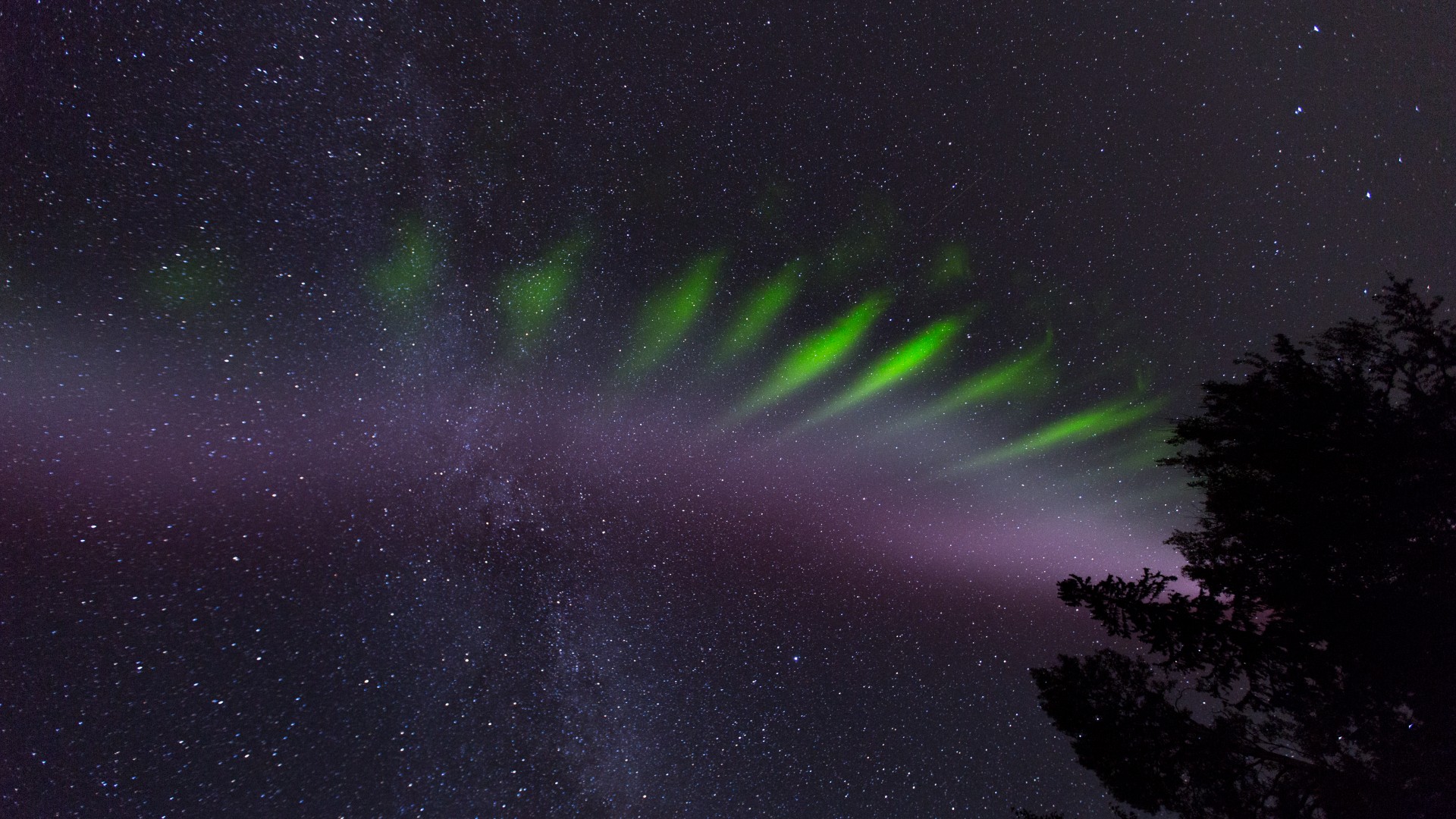Aurora-like 'Steve' phenomenon and glowing 'picket fences' point to unknown exotic physics
"The Steve spectrum is telling us there's some very exotic physics going on. We just didn't know what it was."

The northern and southern lights are among nature's most spectacular sights, providing beautiful light shows that dance across the night skies — but what exactly is an aurora?
Auroras, also known as the northern lights (aurora borealis) or southern lights (aurora australis), are caused by the sun's energy and particles interacting with Earth's atmosphere as the planet's magnetic fields funnel them towards the poles. They are most commonly seen in high-latitude regions around the Arctic and Antarctic.
These colorful light displays generally appear as green bands, but can also occur in red, blue, violet, pink, and white. However, not all light displays seen in Earth's sky are truly auroras. Some purple and white streaks called "STEVE" (Strong Thermal Emission Velocity Enhancement) and a corresponding on-off green glow that resembles a picket fence with jagged points are actually produced by different physical processes making them distinct from auroras.
A recent study of Earth's atmosphere suggests that in a region farther south than that in which auroras form, electric fields parallel to Earth's magnetic field could produce the color spectrum of the picket fence light feature. Similar processes are believed to produce STEVE, which is often accompanied by the picket fence-like streaks, according to a statement from the University of California, Berkeley.
"This would upend our modeling of what creates light and the energy in the aurora in some cases," Claire Gasque, a graduate student in physics at UC Berkeley and lead author of the study, said in the statement.
Related: Where to see the northern lights: 2023 aurora borealis guide
Light shows in Earth's atmosphere are triggered by solar storms and coronal mass ejections (CMEs), which can disturb Earth's magnetic field and funnel ions down towards the poles. Auroras are the result of these ions colliding with atoms of oxygen and nitrogen in Earth's atmosphere, creating green, red and blue light emissions.
Get the Space.com Newsletter
Breaking space news, the latest updates on rocket launches, skywatching events and more!
By comparison, STEVE is generally observed as purple or mauve light, accompanied by a green picket fence — neither of which emit blue light. These phenomena also occur at lower latitudes than auroras.
"If you look at the spectrum of the picket fence, it's much more green than you would expect. And there's none of the blue that's coming from the ionization of nitrogen," Gasque said in the statement. "What that's telling us is that there's only a specific energy range of electrons that can create those colors, and they can't be coming from way out in space down into the atmosphere, because those particles have too much energy."
Instead, the recent study suggests STEVE and the picket fence are generated by low-altitude electric fields parallel to Earth's magnetic field. Using a model of the ionosphere, the researchers showed that a parallel electric field at a height of about 68 miles (110 kilometers) could excite oxygen and nitrogen and generate the spectrum of light observed from the picket fence. Auroras, on the other hand, are generally the result of energized particles at altitudes higher than 621 miles (1,000 km) above the surface.
"The light from the picket fence is being created by particles that have to be energized right there in space by a parallel electric field, which is a completely different mechanism than any of the auroras that we've studied or known before," Gasque said in the statement.
Another author involved with the study says this new research could help us understand unknown physical processes in Earth's atmosphere. "The really interesting thing about Claire's paper is that we've known for a couple of years now that the Steve spectrum is telling us there's some very exotic physics going on. We just didn't know what it was," added Brian Harding, a co-author of the paper, in the statement. "Claire's paper showed that parallel electric fields are capable of explaining this exotic spectrum."
While the energized particles that produce STEVE and the picket fence are probably not from the sun, like auroras, the scrambling of the atmosphere caused by solar storms is still believed to trigger the light shows all the same, according to the study.
Next, the researchers propose launching a rocket through these night sky phenomena to measure the strength and direction of the electric and magnetic fields. And, since these events are triggered by solar storms, the sun's approaching peak activity known as "solar maximum" presents a unique opportunity to study rare events like STEVE and the picket fence.
"It's fair to say that there's going to be a lot of study in the future about how those electric fields got there, what waves they are or aren't associated with, and what that means for the larger energy transfer between Earth's atmosphere and space," Brian Harding, co-author of the paper and an assistant research physicist at UC Berkeley's Space Sciences Laboratory (SSL) said in the statement.
Their findings were published Nov. 3 in the journal Geophysical Research Letters and will be presented at the American Geophysical Union meeting in San Francisco on Dec. 14.
Join our Space Forums to keep talking space on the latest missions, night sky and more! And if you have a news tip, correction or comment, let us know at: community@space.com.

Samantha Mathewson joined Space.com as an intern in the summer of 2016. She received a B.A. in Journalism and Environmental Science at the University of New Haven, in Connecticut. Previously, her work has been published in Nature World News. When not writing or reading about science, Samantha enjoys traveling to new places and taking photos! You can follow her on Twitter @Sam_Ashley13.










